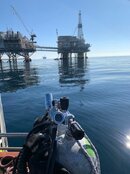OMyMyOHellYes
Contributor
Please help me understand 12, one-minute stops en route to surface (every 10ft or 3M).FWIW, a quick estimate on a direct surfacing return with an AL40 from the "recreational limit" of 130fsw/39msw:
28 litres/min SCR (roughly same as 1cuft/min stressed volume SAC rate in US Imperial units), with 39meters ( 4.9ATA) depth NDL with one minute stops every 3 meters to surface:
4.9 x 28 x 1 = 137.2
4.6 x 28 x 1 = 128.8
4.3 x 28 x 1 = 120.4
4.0 x 28 x 1 = 112
3.7 x 28 x 1 = 103.6
3.4 x 28 x 1 = 95.2
3.1 x 28 x 1 = 86.8
2.8 x 28 x 1 = 78.4
2.5 x 28 x 1 = 70
2.2 x 28 x 1 = 61.6
1.9 x 28 x 1 = 53.2
1.6 x 28 x 1 = 44.8
1.3 x 28 x 1 = 36.4
1.0 x 28 x 1 = 28
Sum Total: 1156.4 litres gas needed for one person to ascend to surface from 39m depth for an emergency contingency with a fairly reasonable & controlled ascent rate.
A 5.5L cylinder (AL40 "pony bottle") filled to 200 bar pressure supplies 1100 litres.
(Note: this is for worst case contingency option only, with no decompression obligation or barely any remaining air left for a "Safety Stop")
If it is a dive within NDL limits there would be -0- required stops en route? 30 ft/minute time would be four minutes, twenty seconds to the surface; 60 ft/minute ascent would be two minutes and ten seconds.




